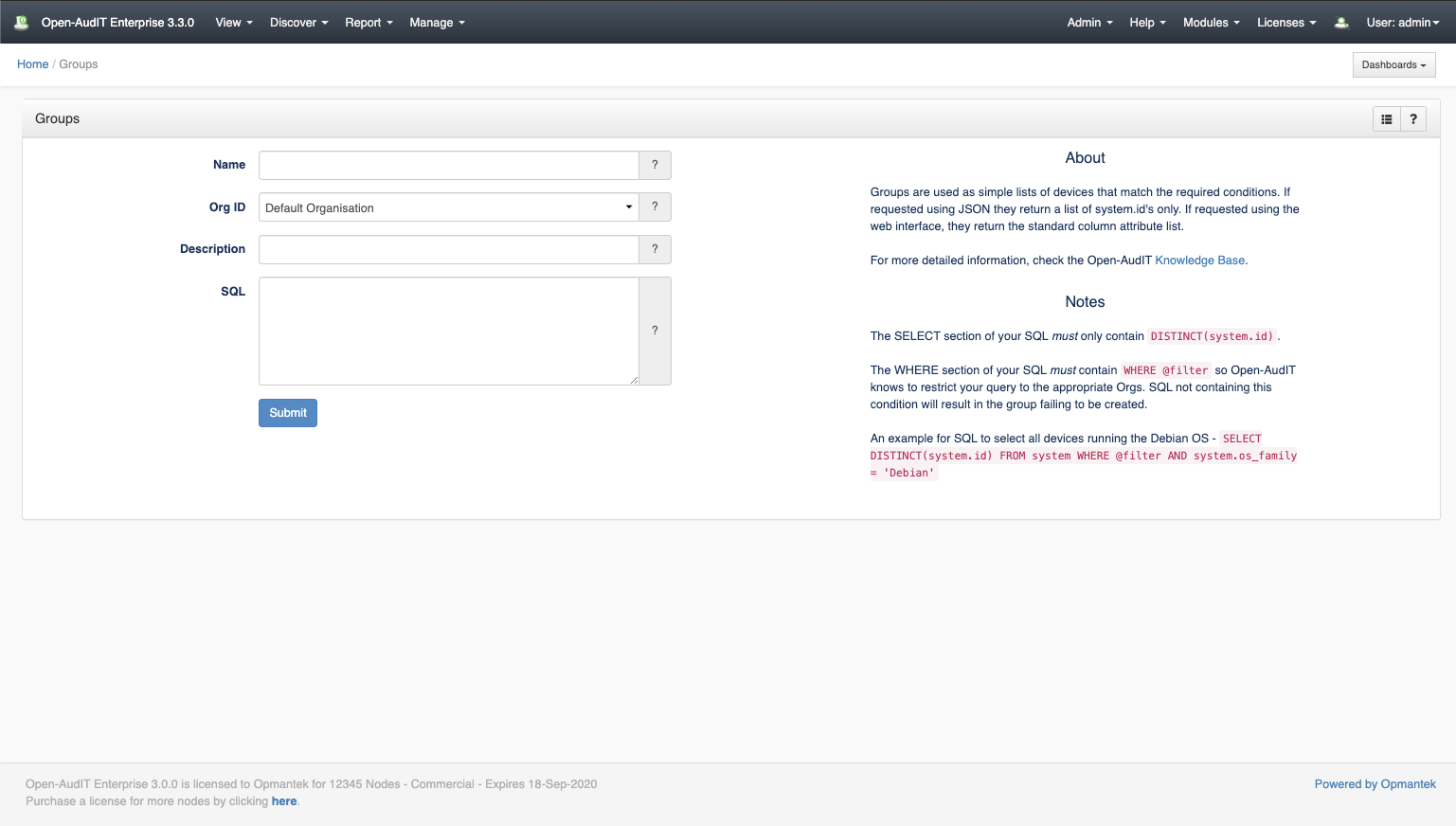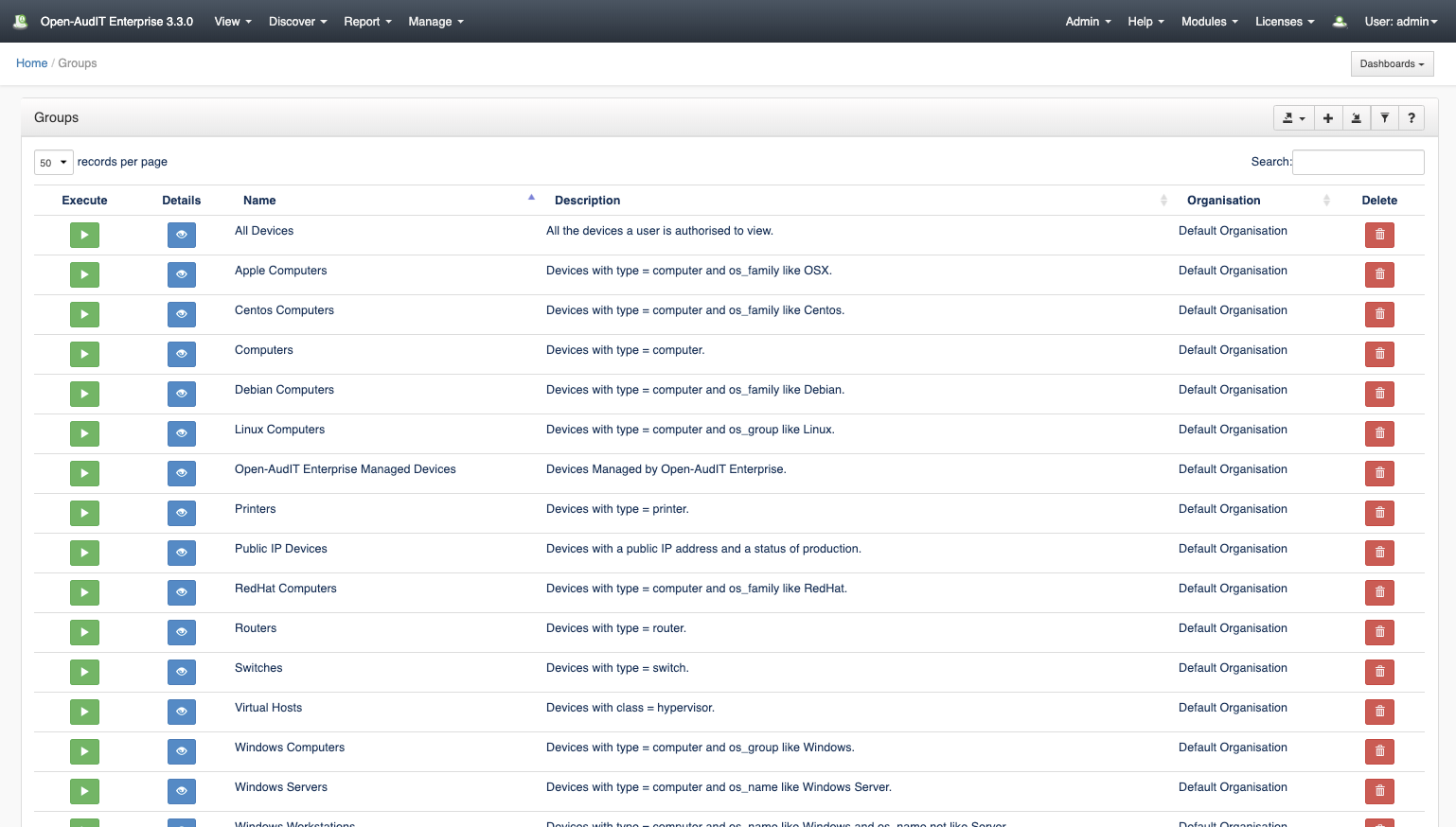| Table of Contents |
|---|
Introduction
As at Open-AudIT 2.0 we have changed the way Groups are used within Open-AudIT. Groups used to be the way to assign a user rights to devices. A user had a level of access to a group (or groups). This is no longer the case.
As at Open-AudIT 2.0, users are assigned a role (or roles) and access is based upon the organisations a user has access to. Groups are used mainly for reporting convienence convenience and Baselines within Open-AudIT Enterprise.
...
A group can be created using the web interface if a user has a role that contains the group::create permission. Go to menu: Manage -> Resources -> Groups -> Create Groups. There is also a create button on the collection page. A user must include the filter clause in the where filter, ie - WHERE @filter. This is required so Open-AudIT can return only those devices a user has access rights to. Examples are on the Help -> Default Group List Defaults -> Default Groups page (see below).
Default Groups
...
View Users Details
Go to menu: Manage-> Groups -> List Groups.
...
| Code Block | ||
|---|---|---|
| ||
mysql> SELECT name FROM groups;
+---------------------------------------+
| name |
+---------------------------------------+
| All Devices |
| Apple Computers |
| Centos Computers |
| Computers |
| Computers |
| Debian Computers |
| Linux Computers |
| Open-AudIT Enterprise Managed Devices |
| Printers |
| Public IP Devices |
| RedHat Computers |
| Routers |
| Switches |
| Windows Computers |
| Windows Servers |
| Windows Workstations |
+---------------------------------------+
16 rows in set (0.00 sec) |
Database Schema
...
Database Schema
The database schema can be found in the application is the user has database::read permission by going to menu
...
: Admin -> Database -> List Tables, then clicking on the details button for the
...
table
...
| Code Block | ||
|---|---|---|
| ||
CREATE TABLE `groups` (
`id` int(10) unsigned NOT NULL AUTO_INCREMENT,
`org_id` int(10) unsigned NOT NULL DEFAULT '1',
`name` varchar(100) NOT NULL DEFAULT '',
`description` text NOT NULL,
`sql` text NOT NULL,
`link` text NOT NULL,
`expose` enum('y','n') NOT NULL DEFAULT 'y',
`edited_by` varchar(200) NOT NULL DEFAULT '',
`edited_date` datetime NOT NULL DEFAULT '2000-01-01 00:00:00',
PRIMARY KEY (`id`)
) ENGINE=InnoDB DEFAULT CHARSET=utf8; |
Example Database Entry
...
| language | sql |
|---|
...
.
...
API / Web Access
You can access the
...
collection using the normal Open-AudIT JSON based API. Just like any other collection. Please
...
see The Open-AudIT API documentation for further details.
API Routes
| Request Method | ID | Action | Resulting Function | Permission Required | URL Example | Notes | Example Response |
|---|---|---|---|---|---|---|---|
| POST | n | create | groups::create | /groups | Insert a new groups entry. | groups_create.json | |
| GET | y | read | groups::read | /groups/{id} | Returns a groups details. | groups_read.json | |
| PATCH | y | update | groups::update | /groups/{id} | Update an attribute of a groups entry. | groups_update.json | |
| DELETE | y | delete | groups::delete | /groups/{id} | Delete a groups entry. | groups_delete.json | |
| GET | n | collection | groups::read | /groups | Returns a list of groups. | groups_collection.json |
Web Application Routes
In addition to the above, when accessing Open-AudIT using a web browser.
...
Default Items
Shipped are a set of default items. These can be found by going to menu: Help → Defaults → Dashboards.
...


